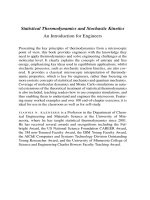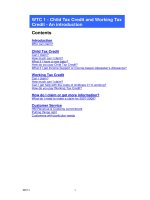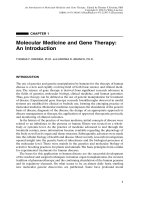Lecture Micro financing and micro leasing - An Introduction - Lecture 17
Bạn đang xem bản rút gọn của tài liệu. Xem và tải ngay bản đầy đủ của tài liệu tại đây (75.11 KB, 47 trang )
Summary of the Last Lecture
New Technology
Corporate Choices
MODELS AND
CORPORATE CHOICES
Financiers
•
The financing of microfinance is especially
appealing for international and investment
banks, because they can use their status
and deal-structuring creativity to bring
microfinance institutions to new kinds of
investors.
Financiers
•
Standard Chartered Bank, for example,
has used its presence throughout Africa
and Asia to develop a portfolio of $170
million across 13 countries financing 41
MFIs. In many cases Standard Chartered
places funds from international investors
who need its assistance to convert dollar
or euro loans into local currency.
Financiers
•
International investors have also been
pouring money into microfinance; total
international investment increased from $1
billion in 2004 to $5.4 billion in 2008. At
first, only socially responsible investors
were interested in inclusive finance, and
deals were far too small for institutional
investors.
Financiers
•
As more mainstream investors enter,
however, they rely heavily on well-known
investment banks for quality assurance.
This means that investment banks and
venture funds have a unique marketmaking role to play in bridging between
worlds.
Financiers
•
The strong reputation and international
connections of Credit Suisse were surely
an important factor in the stunning
success of the Compartamos Banco IPO
in 2007.
Financiers
•
Shares of Compartamos Banco, a
Mexican MFI previously little known to
investors outside Latin America, was sold
by Credit Suisse to American and
European investors (among others) at the
unprecedented share price for a
microfinance institution of 13 times book
value.
Financiers
•
Other high-profile deals included the
Sequoia Capital India investment in SKS
Microfinance and the Deutsche Bank’s
Microcredit Development Fund.
Financiers
•
A decision to finance rather than deliver
does not preclude later direct involvement.
It may even pave the way. Annibale makes
this point with respect to Citibank.
Financiers
•
His unit’s early steps involved investment
banking—bond issues for Compartamos
Banco in Mexico and Mibanco in Peru,
and securitization for BRAC in
Bangladesh.
Financiers
•
After several years of participation at the
investment banking level, Citibank has
begun to experiment with direct retail
provision, for example, in remittances and
payments.
Deliverers
•
If you really want to contribute to solving
the problem of access to quality financial
services, there is no substitute for direct
engagement.
Deliverers
•
Potential champions contemplating direct
delivery must combine cost structure,
branding, market knowledge, and
corporate culture to create a business
success. Organizations well-positioned to
do direct delivery have access to or ways
to develop:
Deliverers
• An extensive net of delivery outlets in lowincome neighborhoods
• A popular sector orientation where they
see themselves, and customers see them,
as friendly to the BOP market, or at least to
“adjacent”market segments like small
business or middle income consumers
• Ability to process and manage millions of
tiny transactions at low cost
Deliverers
•
If parts of this description sound more like
a mass-market retailer than a commercial
bank, it should come as no surprise that
some of the most successful entrants into
inclusive finance, like Banco Azteca in
Mexico, come from retail sectors already
known to customers.
Deliverers
•
Latin American banks and retailers are
more likely than those in other regions to
go into direct service provision, as in the
case of Banco Azteca, Banco Bradesco in
Brazil, and Banco Pichincha in Ecuador.
Deliverers
•
Their motivations include stiff competition
in mainstream markets (such as invasion
of their markets by large international
banks), demonstrated profitability of
microfinance institutions, and the
presence in some cases of underutilized
branch infrastructure.
Deliverers
•
The outcomes of direct delivery strategies
have varied widely from attempts that
never reach many people and are
abandoned after a short time, to major
successes reaching millions of people—
which points to a second set of important
corporate choices.
In-House vs. Partnerships
•
For those bold enough to go into direct
delivery, the next major choice becomes
whether to go it alone or in partnership
with other organizations.
In-House vs. Partnerships
•
Few companies have all the attributes
needed for successful entry, so they must
decide whether to build the new
competencies themselves, acquire them,
or partner with others.
In-House
•
Some organizations decide to build their
own capacity, thus capturing the whole
revenue stream from the operation and
avoiding the difficulties inherent in
partnering arrangements. Companies that
follow this route generally already have
most of the key attributes we mentioned
above.
In-House
•
Even for the best suited organizations,
entry into inclusive finance cannot be
treated simply as new product
development. It often requires the creation
of new structures.
In-House
•
Grupo Elektra, which had an extensive
retail structure, client connections, IT
capability, and a history of financing
consumer purchases, still needed to
create Banco Azteca in order to take full
advantage of the inclusive finance
opportunity.
In-House
•
It created the bank in part for regulatory
reasons, but also to ensure focus in the
new operation. Banco Pichincha of
Ecuador created a new brand, Credifé, to
market itself directly to BOP clients without
affecting its main brand.









